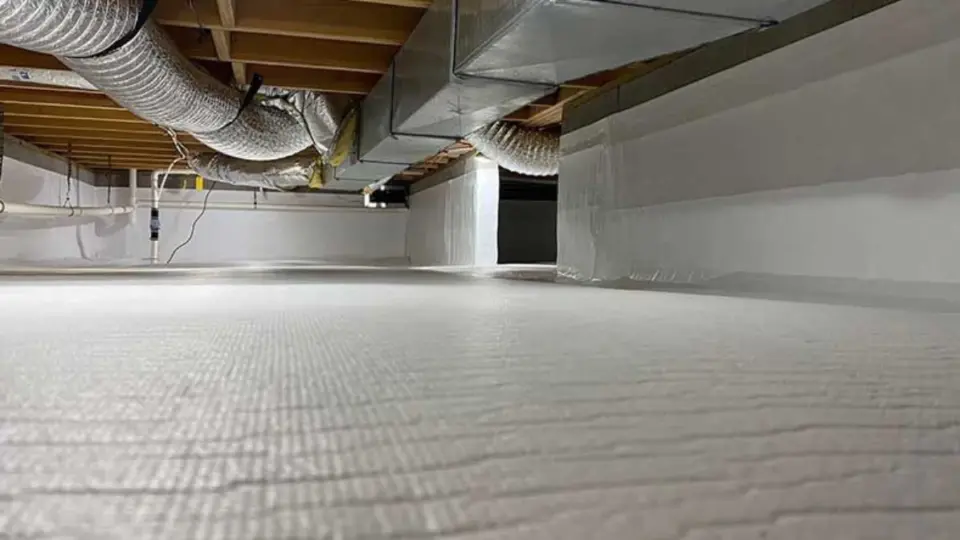
It’s that time of year again. The flowers are blooming, the birds are singing—and your allergies are making sure you don’t enjoy a single moment of it. If you’re like most people, you probably chalk your springtime sneezing, sniffling, and itchy eyes up to pollen. And while that’s certainly part of the problem, there might be another culprit hiding right under your nose—or more accurately, under your floorboards.
Yes, we’re talking about your crawl space.
It turns out, poor crawl space waterproofing doesn’t just affect your home’s structure—it can also play a surprisingly big role in triggering indoor allergy symptoms during the spring season. Let’s take a closer (but fun!) look at how the environment beneath your home might be sabotaging your sinuses.
How Can Crawl Space Moisture Contribute To Indoor Allergy Symptoms During Spring?
When you think “allergies,” you probably picture blooming trees and a yellow haze of pollen on your car. But what’s happening inside your home matters just as much—especially if moisture is creeping into your crawl space.
Crawl spaces are notorious for collecting moisture. Rainfall, high humidity, and rising groundwater levels in spring create the perfect storm (literally) beneath your home. And here’s why that matters: moisture fuels the growth of allergy triggers like mold, mildew, and dust mites.
Once your crawl space becomes a damp, musty space, that air doesn’t stay put. Thanks to something called the stack effect, air from your crawl space rises into your living space. If the crawl space is full of allergens, that means:
- You’re breathing in mold spores without even knowing it
- Your HVAC system might be circulating contaminated air
- Your carpets and furniture may trap allergens, making symptoms worse
So if you’ve ever wondered why your indoor allergies kick up right as the weather turns pleasant—your crawl space could be the answer.
Why Does Poor Crawl Space Waterproofing Worsen Seasonal Allergies?
You might think a few puddles or a damp smell under the house isn’t a big deal. But when your crawl space isn’t properly waterproofed, it becomes an incubator for allergy triggers—and spring is prime time for things to get out of control.
Here’s why poor waterproofing makes everything worse:
1. Humidity Is the Enemy
Spring brings rain, and rain brings moisture. Without waterproofing, crawl spaces stay damp long after the rain stops. That extra moisture leads to:
- Rapid mold and mildew growth
- Expansion of wood materials that trap allergens
- Increased dust mite activity (they love humid environments)
2. Ventilation Isn’t Enough
Many older homes rely on vented crawl spaces to manage moisture. But in spring, vents can let in humid air, which condenses and adds to the moisture problem instead of fixing it.
3. Insulation Gets Compromised
Wet crawl spaces ruin insulation. Damaged or wet insulation can harbor allergens and reduce temperature control in your home—contributing to damp, uncomfortable living spaces.
So not only are you breathing in spring pollen, but you’re also inhaling a cocktail of indoor allergens that your crawl space helped brew. And all of that is happening while you think you’re safe indoors.
What Role Does Mold In Crawl Spaces Play In Triggering Spring Allergies?
Let’s get something straight—mold is no joke, especially when it comes to allergies.
Mold spores are microscopic, which means they can easily float into your home’s air without you even realizing it. Once inhaled, these spores can irritate the respiratory system, trigger allergy symptoms, and even lead to long-term health issues for people with asthma or compromised immune systems.
Common symptoms caused or worsened by mold exposure include:
- Sneezing and runny nose
- Itchy, watery eyes
- Wheezing and coughing
- Skin rashes or irritation
- Headaches or fatigue
When mold grows in a crawl space, it’s usually because of long-standing moisture issues. And unfortunately, spring’s humid weather gives mold the perfect breeding conditions to thrive and spread.
What’s worse? Many homeowners don’t even realize they have mold under the house. It’s out of sight—and out of mind—until their symptoms flare up every spring and they blame the trees instead of the floor.
Crawl space mold can be especially harmful if:
- You have carpeting on the first floor (traps spores)
- Your HVAC system pulls air from near or around the crawl space
- You have any allergies, asthma, or chronic sinus issues already
Think of it this way: your crawl space might be functioning like an unintentional mold diffuser. Not exactly the home feature you were hoping for.
Can Improving Crawl Space Conditions Help Reduce Allergy Flare Ups Indoors?
Absolutely—and the best part is, crawl space improvement is one of the few home upgrades that can benefit both your health and your property value.
By investing in crawl space waterproofing, you’re not just keeping water out. You’re creating a healthier, cleaner air environment for your family.
Here’s how it helps:
- Encapsulation prevents moisture from entering in the first place, sealing off your crawl space from outdoor humidity and rain.
- A vapor barrier creates a protective layer, blocking ground moisture and mold growth.
- Dehumidifiers can regulate indoor air quality, preventing mold and dust mites from thriving.
- Proper drainage systems redirect rainwater and reduce standing water under your home.
This all adds up to a drier, cleaner crawl space—and by extension, a more breathable home. If you’ve been relying on allergy medication every spring just to survive your own living room, this is a solution that gets to the root of the problem (literally).
Plus, you’ll notice added bonuses like:
- Fewer musty odors indoors
- Better HVAC efficiency
- More stable indoor humidity levels
- Peace of mind when spring storms hit
Don’t Blame the Trees Just Yet
Yes, pollen is a problem. But if you’re dealing with spring allergies that just don’t let up, it might be time to stop blaming nature and take a look under your house.
Your crawl space plays a bigger role in your indoor air quality than you might think. And if it’s damp, musty, or moldy, it’s essentially working against you every time allergy season rolls around.
The good news? It doesn’t have to stay that way. Crawl space waterproofing is a smart, long-term investment that not only protects your home—it protects your health. You wouldn’t ignore a leak in your ceiling, so don’t ignore what’s happening below your feet.
Breathe Easier This Spring—From the Ground Up
If your allergies are kicking up and your crawl space has been out of sight and out of mind, it’s time to change that. At Freedom Crawlspace Services, we help homeowners identify and fix hidden moisture issues that could be affecting their health.
From encapsulation to drainage and dehumidification, we provide customized solutions to keep your crawl space—and your indoor air—clean and healthy.
Take control of your spring allergies from the ground up. Contact Freedom Crawlspace Services today for an inspection, and let’s get you breathing easier in every season.
